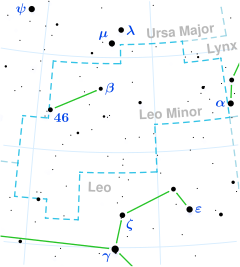| Observation data Epoch J2000 Equinox J2000 | |
|---|---|
| Constellation | Leo Minor |
| Right ascension | 10h 45m 51.8947s[1] |
| Declination | +30° 40′ 56.307″[1] |
| Apparent magnitude (V) | 5.35±0.01[2] |
| Characteristics | |
| Spectral type | B9 V[3] |
| U−B color index | −0.16[4] |
| B−V color index | −0.06[4] |
| Astrometry | |
| Radial velocity (Rv) | 12±3.7[5] km/s |
| Proper motion (μ) | RA: −20.344 mas/yr[1] Dec.: −38.234 mas/yr[1] |
| Parallax (π) | 7.915 ± 0.0813 mas |
| Distance | 412 ± 4 ly (126 ± 1 pc) |
| Absolute magnitude (MV) | +0.02[6] |
| Details | |
| Mass | 2.77±0.36[7] M☉ |
| Radius | 3.29±0.11[7] R☉ |
| Luminosity | 107[8] L☉ |
| Surface gravity (log g) | 4±0.2[9] cgs |
| Temperature | 10,703±206[7] K |
| Rotational velocity (v sin i) | 145[10] km/s |
| Age | 69+199 −59[9] Myr |
| Other designations | |
| Database references | |
| SIMBAD | data |
42 Leonis Minoris (42 LMi) is a solitary,[11] bluish-white hued star located in the northern constellation Leo Minor. It has a visual apparent magnitude of 5.35,[2] allowing it to be faintly seen with the naked eye. Parallax measurements place it at a distance of 412 light years.[1] The object has a heliocentric radial velocity of 12 km/s,[5] indicating that it is drifting away from the Solar System.
42 LMi has a general stellar classification of B9 V,[3] indicating that it is an ordinary B-type main-sequence star. However, Cowley et al. (1969) gave a slightly cooler class of A1 Vn,[12] indicating that it is instead an A-type main-sequence star with 'nebulous' (broad) absorption lines due to rapid rotation. Nevertheless, it has 2.77 times the mass of the Sun and a radius of 3.3 R☉.[7] It radiates at 107 times the luminosity of the Sun[8] from its photosphere at an effective temperature of 10,703 K.[7] Its high luminosity and slightly enlarged diameter suggests that the object might be evolved. Like most hot stars, 42 LMi spins rapidly with a projected rotational velocity of 145 km/s.[10]
There are two optical companions located near this star. BD+31°2181 is a 7th magnitude K2 giant star separated 146″ away along a position angle of 174°.[13] An 8th magnitude companion has been detected at a distance of over 400 arcseconds along a position angle of 92°.[13] Both have no relation to 42 LMi and is just moving with it by coincidence.
An X-ray emission with a luminosity of 278.2×1020 W has been detected around the object. A-type stars are not expected to emmit X-rays, so it must be coming from an unseen companion.[14]
- ^ a b c d Cite error: The named reference
EDR3was invoked but never defined (see the help page). - ^ a b Cite error: The named reference
Tycho2000was invoked but never defined (see the help page). - ^ a b Cite error: The named reference
Osawa1959was invoked but never defined (see the help page). - ^ a b Cite error: The named reference
Crawford1963was invoked but never defined (see the help page). - ^ a b Cite error: The named reference
Karchenko2007was invoked but never defined (see the help page). - ^ Cite error: The named reference
Anderson2012was invoked but never defined (see the help page). - ^ a b c d e Cite error: The named reference
Stassun2019was invoked but never defined (see the help page). - ^ a b Cite error: The named reference
McDonald2017was invoked but never defined (see the help page). - ^ a b Cite error: The named reference
Gullikson2016was invoked but never defined (see the help page). - ^ a b Cite error: The named reference
Dworetsky1974was invoked but never defined (see the help page). - ^ Cite error: The named reference
Eggleton2008was invoked but never defined (see the help page). - ^ Cite error: The named reference
Cowley1969was invoked but never defined (see the help page). - ^ a b Cite error: The named reference
Mason2001was invoked but never defined (see the help page). - ^ Cite error: The named reference
Schröder2007was invoked but never defined (see the help page).
